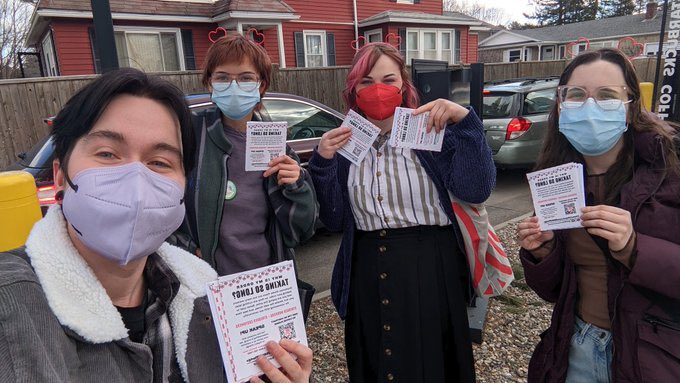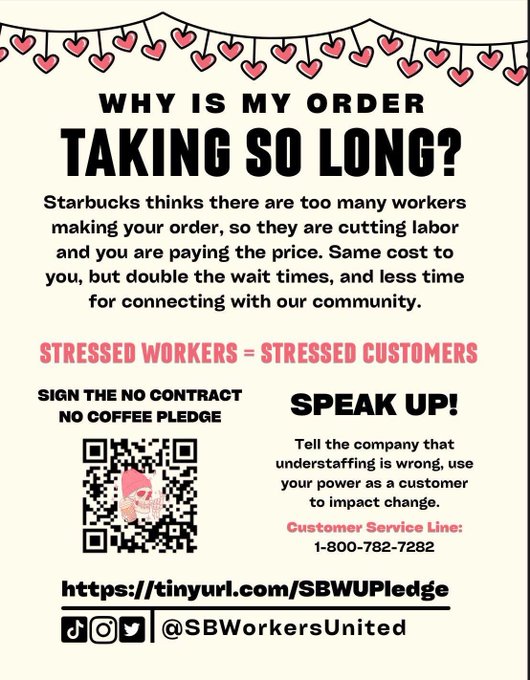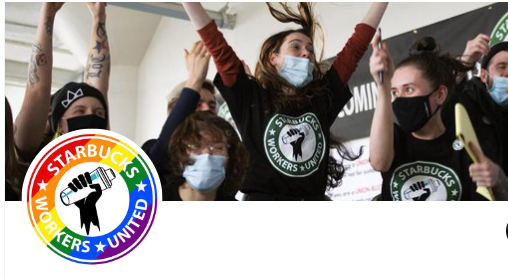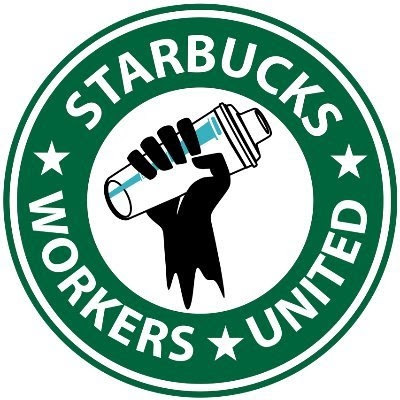Labor Breakthrough (Tyrone Wallace)
Reposted from MR Online
Workers at 400 Starbucks stores across the country have won union elections. On Feb. 27, after more than two years of union-busting campaigns and stalling on negotiations, the company announced it would begin to bargain in good faith with the Starbucks Workers United union. It also promised to grant raises and benefits to the unionized shops, which it has been illegally denying.

On March 19, Starbucks said it would begin bargaining in late April with workers from the unionized stores nationally, instead of store by store. That day, workers at nine more Starbucks stores in eight states filed to have their union recognized.
The workers’ main demands include a minimum wage of $20 per hour, more consistent scheduling and increased staffing levels.
“This is amazing,” says worker-organizer Melina Carrasquillo, 26. “I had initially thought coming into this that we were going to be stuck for at least a year or two in limbo, like how it has been for the movement prior to us.” She works at a Starbucks in Park Slope that was one of 21 shops that launched their campaigns together in mid-February.
Labor historian Eric Blanc says the Starbucks campaign might be the most significant win for labor since the 1930s, because “nobody [since then] has shown it’s been possible not just to win elections, but to get to a first contract against the biggest corporations in the world in our modern economy.”
Factors that might have changed Starbucks’ calculations include that it has spent at least $240 million on union-busting lawyers that failed to stop organizing. It has faced repeated defeats at the federal National Labor Relations Board (NLRB), damage to its “progressive” brand identity, and a shareholder revolt that sought to place three union-friendly directors on the company’s board.
Brendan Lopez, a worker-organizer who was fired from a Starbucks in Farmingville, Long Island, told The Indypendent that he thinks an international boycott movement against Starbucks after the company tried to punish the union for its pro-Palestine position played a crucial role in forcing the company’s hand.
Whatever the company’s intentions were, “we have all been celebrating,” says Lopez.
They were sending lawyers to go in and then leave immediately. Lawyers would not even show up in a meeting sometimes to bargain, and if they would show up, they would just be on their phones, or not even pay attention to the meeting, and then they would just leave.
The baristas The Indypendent spoke with, however, remain wary of the company’s intentions. It recently entered, along with Amazon and Trader Joe’s, in a legal battle started by Elon Musk’s SpaceX that seeks to declare the NLRB’s power to enforce New Deal-era labor laws that protect workers’ right to form unions unconstitutional.
Regardless, this is a sign that the insurgent labor movement is maintaining momentum, says veteran unionist Eric Dirnbach.
“What is management looking for?” he asks.
They’re looking for signs that the union momentum is dissipated. If the union momentum were dissipating, they would hold out, they would not reach out for a deal. They’re seeing the opposite. They’re seeing this not going away, so they’re making a business decision.
Organizing in the City
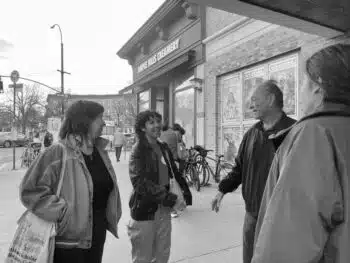
Since winning its first union election in Buffalo in December 2021, Starbucks Workers United has helped inspire a wave of organizing by younger workers in retail and service industry jobs that were long thought to be impossible to unionize.
Here in New York City, workers at Starbucks, Barboncino pizzeria, Death and Co. bar, Hex & Company boardgame cafe, She Wolf Bakery, Housing Works, Greenlight Bookstore, Barnes & Noble, REI, Trader Joe’s, Film Forum, Alamo Drafthouse Cinema Lower Manhattan and Nitehawk Cinema have won union elections or begun the process of organizing a union.
Workers in service and retail jobs make up at least 46.3 million of the roughly 160 million people employed in the United States in 2023, according to data from the federal Bureau of Labor Statistics. These industries, whose share of the workforce grew after deindustrialization hit the U.S. in the 1970s, have some of the country’s lowest unionization rates–between 1.3% and 4.6%.
Downward mobility among millennial and Zoomer workers in the United States has also spurred unionization, as more college-educated workers are finding themselves working in service and retail jobs for years.
“People my age are seeing these jobs that we’ve been raised to think of as lesser and have low value, that we are now working because the economy is not very good, and then we can sort of get stuck in them,” says Esther, 29, a barista at Barnes and Noble.
With high turnover rates and “easily replaceable” jobs, service and retail workers have been considered nearly impossible to organize, but being hailed as “essential workers” who had to endure great risk during the pandemic helped spark a new desire to fight for their rights in the workplace. These occupations, often rife with safety and health hazards and bosses that care more about customer happiness than workers’ wellbeing, are proving to be fertile grounds for unionization.
“We are now seeing that that labor is actually incredibly valuable, that it’s really hard work, that it’s a lot of effort, and that it’s not right–not just societally–but that these companies treat us like we’re just disposable,” says Esther, who graduated from a masters program in 2020 with a degree in media archiving and preservation. Unable to find a job in her field, and having worked previously at Starbucks barista, she got a position in the cafe at the Barnes and Noble bookstore on 82nd Street in Manhattan in mid-2023.
Esther was eager to join the union push. “Pay is a big issue for everyone, not being able to afford to live in the neighborhood where we work is something we all came together and said, ‘This is not right. Our labor is worth more than what we’re being paid,’” she told The Indy.
On March 14, 85% of them voted to join the Retail, Wholesale and Department Store Union. In June, 88% of workers at the Park Slope Barnes and Nobles and 97% at the company’s flagship store in Union Square voted to join the same union. They are some of seven stores in the country that have unionized since May 2023.
Alex Dinndorf, 26, who was one of the workers who formed a union at the Barboncino pizzeria in Brooklyn last year and now is an organizer with Workers United, says another reason service workers are particularly motivated to unionize is that “the service economy is becoming more consolidated under corporate restaurant groups,” and that that is happening because “all of these restaurants are becoming so expensive to operate.”
While workers at local businesses or small chains have faced union-busting tactics, they generally pale in comparison to the anti-union campaigns at Trader Joe’s, Starbucks and REI which can afford to pay hundreds of dollars per hour to lawyers from top-tier law firms that specialize in “union avoidance.”
At Nitehawk Cinema Prospect Park in Brooklyn, the local owner aggressively opposed the Nitehawk Workers Union after it went public.
Workers there started organizing last August. “The workers reached out to the Barboncino Union Twitter,” said Dinndorf. He supported organizing at Nitehawk as a volunteer with the Emergency Workplace Organizing Committee (EWOC), which formed in 2020 as an organizing tool for workers to fight for better working conditions and form unions at their shops.
Nitehawk, where theatergoers are served food and drinks while they watch movies, “is an absolute factory,” Dinndorf says. “The food runners there wear earpieces to communicate,” and servers carry “trays of drinks weaving up and down stairs, crouching–the conditions are notoriously bad.”
“I had heard stories about Nitehawk and Alamo well before I started organizing anything, and it always had the reputation of a place that was really tough to work at and have no work-life balance” during major film releases, he adds. The Barbie/Oppenheimer double release proved to be “the big catalyzing incident at Nitehawk” that led to the workers’ decision to organize.
On March 17, workers voted 51-41 to join United Auto Workers (UAW) Local 2179, with 90% of the staff voting.
“I’m looking forward to hearing from those 41 people that did vote no, so we’ll be able to take those grievances and work them out,” worker-organizer Lydia told The Indypendent. She said the close vote was “pretty understandable, given mistakes that were made by the organizing committee, as well as the union-busting tactics that were used against our shop.” She says that the campaign was the first union experience for “pretty much all” the worker-organizers at Nitehawk.
Nitehawk owner Matthew Viragh, Lydia says, spread misinformation about unions and what might happen at the cinema if a union were to win, as well as rumors about some of the pro-union workers. The UAW filed unfair labor practice charges against Nitehawk for threatening to fire union supporters, cut their benefits, and deny them special privileges, all illegal under the National Labor Relations Act.
Standing outside Nitehawk after the election results were announced, Dinndorf, Lydia, another worker and their new union representative from UAW Local 2179 excitedly hugged and shook hands.
The Local 2179 representative, a veteran labor organizer, said he was happy to welcome more movie theaters into the local. “This will be our third theater in a year,” he said in a strong New York accent as he smoked a cigarette. “There’s Nitehawk, Alamo Theatre and Drafthouse and another one.” He said with a sly smile meaning, ‘It’s a new campaign; we can’t tell you yet.’
“It’s incredible to be a part of this enormous mobilization of organized labor that’s been happening since the beginning of the COVID pandemic in 2020 with the Amazon Labor Union, as well as Starbucks and Trader Joe’s, and even smaller shops, not just in New York City, but across the entire United States,” said Lydia.
Sticking it to Corporate

At a sidewalk tabling event to collect signatures from customers and community members that support the union campaign at the Starbucks on Fourth Avenue and 11th Street in Park Slope, sometimes a queue formed as people waited to sign on one of the two devices available.
“Sure, I love you guys,” said one elderly regular, when workers asked him to sign.
“It’s so weird that it has to be location by location,” added another regular, about the fact that a union can’t be won for every franchise at once.
“I did plumbing work for a while and obviously there was a union for a good reason, and fuck these corporates,” said a young man who had stopped to sign the petition.
“We’re getting a lot more signatures than I expected today,” said Starbucks worker-organizer Victoria Blair, 24.
“I’ve been running in left-wing, trade-unionist, pro-labor circles since I was 13,” said Blair. She grew up poor in Texas, moving around from home to home, with a brother with special needs, so she had to learn to advocate for them, and through that, got involved in politics at a young age. “I didn’t know at the time that I was queer, but I knew something was different about me–so it was a burning desire to understand why marginalized people are marginalized.” That led her to critical analysis of gender and ability,
which leads into critical analysis of the socio-economic status quo, into Marxist critical analysis.
“I always have been a bit of a firebrand,” added Blair.
She moved to Brooklyn in July in part because of the “ongoing persecution of transgender people in Texas,” she said. She had tried to unionize the Starbucks she was working at in Arlington, Texas, to little avail and thought she would take another shot at it when she transferred to the Park Slope store.
Melina Carrasquillo, who had been working at the Starbucks for around a year and a half, was itching for someone to start a union campaign there but was nervous to be the one to spearhead it, partially because she was hoping to be promoted to a managerial position.
One day last fall, Blair mentioned her plan to Carrasquillo, who begged her to follow through with it, promising she would help. “I realized the union was more important to me than getting a promotion,” said Carrasquillo, who grew up around organized labor because her father is a shop steward at the National Association of Letter Carriers union for postal workers.
“We thought that you show up to any company, and you have to take the rules that are in place, you have to take the injustices and discrimination,” Carasquillo told The Indy. “But we’re coming to a place in our country and generation where we’re realizing that we don’t have to accept this as the status quo.” The union election at her store will take place on March 28.
Brendan Lopez, 23, who was fired from the Farmingville Starbucks last July, was one of the first workers to participate in organizing there.
“I had just started, and someone had written ‘Start union now’ on the whiteboard in the break room,” he recalls. Lopez walked in while an anti-union supervisor was examining the note and yelled at Lopez, saying he would fire whoever was responsible. “My response was, ‘If you’re gonna yell in my face, I’m gonna go be a part of the union then.’” He started organizing with the worker who had written the note.
Despite gridlocked negotiations, Farmingville Starbucks workers continue to hold regular union meetings. Lopez and other workers also traveled around to different Starbucks franchises on Long Island to inform other baristas about the union efforts. After he was terminated, Lopez and his coworkers went to Starbucks’ corporate offices in Manhattan and marched on the boss for firing a key worker-organizer.
Corporate union-busting has standard tactics: firing organizing workers, threatening to demote or fire them for union activity, promoting misinformation campaigns that claim unions will result in lower pay and benefits and lost jobs, mandatory “captive audience” meetings with anti-union propaganda and veiled threats, and taking down or prohibiting pro-union literature in the break room. If a union wins an election, employers often stall or refuse to bargain a first contract and deny the unionized workers the same raises and benefits it gives other workers, as both Starbucks and REI have done. All those tactics are illegal under federal labor law, but still frequent.
At REI Soho, workers have been denied company-wide raises since they voted to join the Retail, Wholesale and Department Store Union in March 2022. All the unionized workers in the United States recently found out that they would be denied end-of-year “merit” bonuses.
Carlos Angel-Barajas, 34, an actor with a master’s degree in the field, is on the REI Soho bargaining committee. After one year of bargaining, REI changed law firms and hired the notoriously anti-union Morgan Lewis. Now, two years after winning their union election, neither REI Soho workers nor those at eight other recently-unionized stores are anywhere near reaching a deal with the company.
“When we bargained with [the previous firm], there were representatives from REI on the Zoom call,” Angel-Barajas recalls. “It was a very slow, at times frustrating, process but there were things that were handled at the bargaining table because REI was present.” Now, he says, “it’s just the legal team; there are no REI representatives,” and not one additional tentative agreement has been made.
Workers at REI stores nationwide have filed more than 80 complaints with the NLRB, seeking to force the company to bargain first contracts.
At the Trader Joe’s on Essex and Delancey in Lower Manhattan, bosses approached union-busting in a more creative way. “Trader Joe’s doesn’t have to hire professional union busters to come in–they are just using the employees to do that work,” says labor lawyer Seth Goldstein.
After losing a union election in a 76-76 tie last spring, workers haven’t stopped organizing, and the boss continues to hire anti-union workers who have formed an unofficial union-busting clan, says independent union Trader Joe’s United.
Things came to a head in February when Fredd Moore, a queer pro-union worker, was fired on what the union says are trumped-up claims after being called homophobic slurs by one of the anti-union workers.
“They truly believe that if we get a union, we will lose our jobs,” said worker-organizer Jordan Pollack of the anti-union group.
The union’s legal team, Julian, Mehrer, Singla and Goldstein, has filed an unfair-labor-practice charge against Moore’s firing. It has also appealed the election results and is hoping to have them overturned under the precedent set in the NLRB’s Cemex ruling last August, which stipulates that if management illegally interfered with an election, the employer will be ordered to recognize the union, rather than having to redo the election.
Workers at Amazon’s JFK8 warehouse on Staten Island, the only unionized Amazon warehouse in the United States, faced a grueling anti-union campaign, with workers forced to sit through several captive-audience meetings before the April 2022 union election, which the Amazon Labor Union won. Amazon also fired several union leaders before and after the election. It has not yet begun to negotiate a contract.
The independent Amazon Labor Union also has internal problems. There has been a split between union president Chris Smalls and his supporters, and some of the union’s organizers who came from outside and took jobs as “salts” at the JFK8 warehouse to build support for the union. JFK8 workers recently voted to have direct elections for their leadership which will be held in the coming months. Meanwhile, the 1.3-million member Teamsters union vowed to organize Amazon after winning a strong contract from UPS last summer.
Labor organizers and union lawyers have been sounding the alarm as the world’s richest men fight against the labor movement by attempting to destroy the NLRB’s power to enforce the National Labor Relations Act. The law, enacted in 1935, protects the rights of private-sector workers to unionize and engage in other “concerted activity.” In June, Starbucks followed Trader Joe’s and Amazon making legal filings that support SpaceX’s argument in a lawsuit claiming that the NLRB’s administrative process for hearing cases violates its constitutional due-process rights.
“This is just a blatant attack on the labor movement for their success in organizing,” says labor lawyer Seth Goldstein.
Maintaining Momentum

“I was a socialist in the ’90s. It was very hard; there were like five of us in the meetings,” labor organizer Eric Dirnbach told The Indy. Now, he attends packed meetings full of excited young labor organizers and socialists.
New unions and militant union-support networks like the Emergency Workplace Organizing Committee are paving the way for effective worker-to-worker organizing, and well-established unions like the Teamsters and the UAW have been revitalized by grassroots pro-democracy campaigns.
EWOC, a joint, volunteer-run project between the United Electrical Workers union and the Democratic Socialists of America, says it has around 500 currently active organizing volunteers; that over 5,200 workers have reached out to it since its founding; and that of these, over 2,100 campaigns have been launched with some organizing activity, representing workers at over 1,500 employers.
Younger people are gaining class consciousness, after more than 40 years of declining economic conditions for workers. We are paying more than ever for higher education, housing, groceries, health care and more, while the share of wealth controlled by the richest 1% continues to grow.
“I think for our generation, a promise was made about working hard, getting an education, buying a house. We saw examples of it by our parents and grandparents,” says Angel-Barajas,
and it turned out to be empty.
Gay and transgender people, particularly those of color, face high rates of workplace discrimination and harassment. At Starbucks, Trader Joe’s, REI and Nitehawk, queer workers are leading the way.
Angel-Barajas is queer and was undocumented for much of his life. “I, along with a bunch of my coworkers, are uniquely tuned into systems of oppression, and we’re tuned into methods, tactics, for those in power to control,” they said. “And I’ve seen how powerfully folks in the store will fight for one another. It’s difficult work, but it’s also very important and transformative.
Workers are becoming aware that they cannot fix working conditions by just changing jobs. “I come from a line of horrible work experience. I have yet to find a job that has a good management, a good foundation for its workers,” says Lopez.
I know what it feels like to be an ant underneath a shoe, and it’s not a good feeling that you can be replaced by any other worker ant, and you’ll just be another squashed bug on the side of the road.
Lopez says another reason he hasn’t given up is because he has a whole new community of friends and support through the union.
I’m constantly asking everybody new I meet, ‘If you ever need a union, let me know.’
Millennials and Zoomers grew up in a time when union membership was at its lowest ebb in generations in the United States, and knowledge about unions and labor issues was slim or nonexistent. None of the workers I spoke with for this article remember being taught much of anything about organized labor and its history. We heard snippets about it during Occupy Wall Street, the Fight for $15, Bernie Sanders’ presidential campaigns and the Chicago teachers strikes. In March 2020, when Amazon workers bucked at Jeff Bezos, then the richest man in the world, we were ready to follow suit.
Originally published in The Indypendent
Amba Guerguerian is The Indypendent’s Associate Editor.



